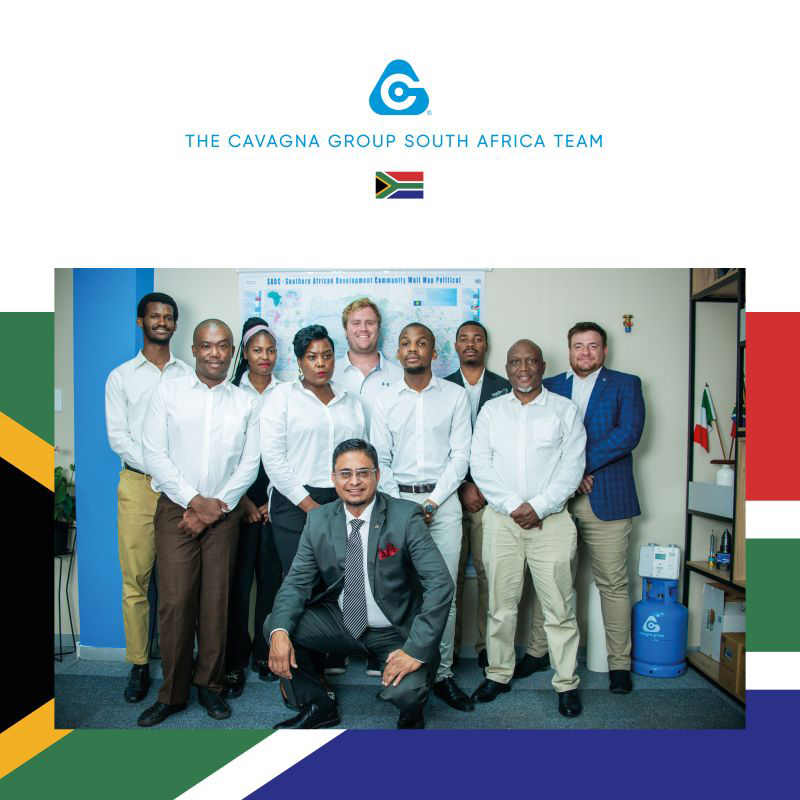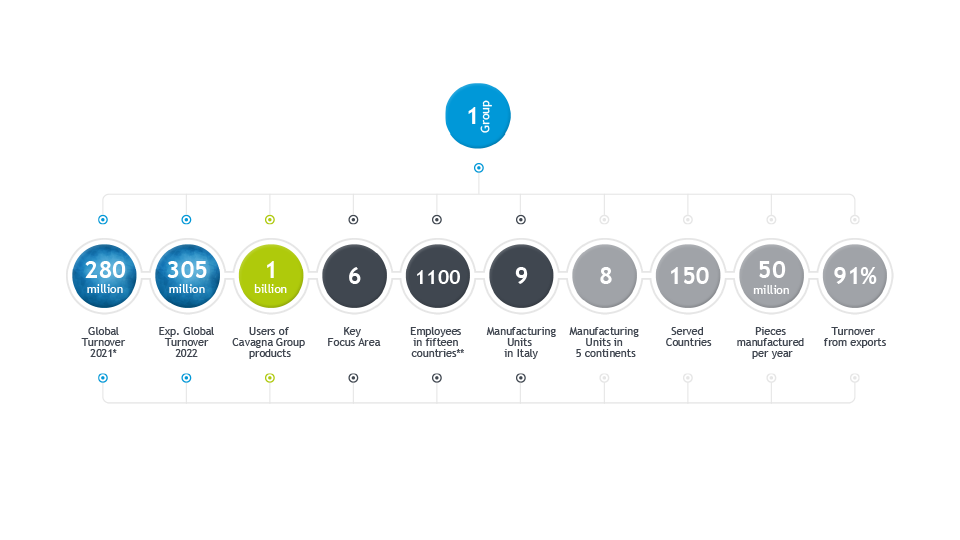Cavagna Group South Africa Proprietary Limited

Cavagna Group South Africa (CGSA), established in 2021, is a proud subsidiary of the globally renowned Cavagna Group. As a trusted leader in the manufacture and supply of high-quality gas control equipment and components, CGSA brings world-class innovation, safety, and reliability to the Southern African energy sector. Our fully established gas metering facility enables us to meet diverse industry needs with precision and efficiency.
We are proud to be a Level 4 contributor to Broad-Based Black Economic Empowerment (B-BBEE), demonstrating our ongoing commitment to inclusive economic growth in South Africa. Additionally, CGSA operates under the internationally recognised ISO 9001:2015 quality management system, ensuring our products and services consistently meet the highest global standards. We have local warehousing of critical stock items.
Mission
“Starting from innovation, wherever gas is the integral part and provides clean energy for everyday life, there will be the technological and productive commitment from Cavagna Group. Comprehensive one-stop solutions for each type of gas, to promote safe and functional utilization in all applications.”
Internal Issues
Internal factors are those within the organization that can influence its ability to achieve its objectives.
Category
• Organizational Structure and Culture
Example of Internal Issues: Hierarchical or flat structure, leadership styles, decision-making processes.
Process efficiency
• Inefficient workflows – The steps within the processes are smooth and not repetitive.
• Outdated technology – The software and systems are always updated and designed for current needs to speed up the tasks and clear
compatibility issues
• Lack of process documentation – There are clear guidelines (written procedures) outlining how the processes should be followed to
ensure consistency and prevent/ minimize errors and confusion among team members.
Resource management
• Staff skill gaps – It is ensured that there are no significant differences between the skills required for a job and the skills currently
possessed by the employees in their roles.
• Inadequate training – The employees are provided with training programs that are sufficient to identify skill gaps by quality training
materials and quality training time targeting the right skills.
• Resource allocation issues – The employees are assigned tasks/ projects based on their skills and availability to avoid project delays
and quality concerns.
Internal communication
• Information silos – It is ensured that different departments do not operate in isolation, readily sharing updates or critical
details, and not creating a knowledge gap.
• Delayed communication – It is ensured that the important news is communicated promptly across departments to avoid
missed deadlines and misaligned efforts.
• Unclear expectations – transparent communication is required to ensure that individuals are aware of what is expected
from their teams. This is to ensure understanding and unduplicated work.
Quality control practices
• Deficiencies in quality checks – Identify and address potential issues quickly and effectively while still maintaining a high
standard of quality in the product or service being checked; essentially, doing a thorough quality check while optimizing the
process to be as productive as possible.
• Inconsistent application of standards – Rules, policies, or expectations are applied firmly across situations or individuals for
fair non-discrepancies where similar cases are treated differently. This is to avoid a lack of equity and the potential for bias.
External Issues
External factors originate outside the organization but can influence its operations and strategic direction.
Economic Factors
• Economic fluctuations – Diversifying income sources, closely managing costs, building emergency funds, adapting to market
changes, maintaining efficient cash flow, identifying potential opportunities during downturns, and staying informed about economic
trends
• Current exchange rate – Regular monitoring of market fluctuations.
• Raw material cost – Carefully tracking the raw material usage, negotiating with suppliers, diversifying the sourcing options,
optimizing inventory levels, implementing lean manufacturing practices to reduce waste, monitoring price fluctuations, and
considering alternative materials or production processes when possible.
Market trends
• Customer demands – Prioritizing active listening, demonstrating empathy, clearly communicating with customers, managing
expectations, staying calm, and being open to feedback, while also assessing their needs and finding solutions to address their
concerns thoughtfully; essentially, strive to create a customer-centric culture where you prioritize understanding and meeting
customer needs. Emerging technologies – New or recently introduced technologies that have the potential to change society and the
economy
• Emerging technology – actively staying informed about new advancements, assessing their potential impact on your field, evaluating
their feasibility for your business, considering pilot projects to test them, and fostering a culture of continuous learning within your
organization to adapt and potentially leverage new technologies as they arise.
• Competitor activity – Conducting a thorough competitor analysis to understand their strengths and weaknesses, identifying
market gaps, and then leveraging our unique selling proposition (USP) to differentiate our product or service, while actively
monitoring their actions to adapt our strategies accordingly; key steps include identifying y competitors, analyzing their
products and marketing strategies, and developing a strategy to highlight our unique advantages in the market.
Social environmental factors
• Sustainability concerns – conducting a sustainability assessment, reducing waste, switching to renewable energy, optimizing
resource usage, engaging with your supply chain to ensure ethical practices, promoting transparency, setting clear
sustainability goals, and actively monitoring progress while incorporating environmental, social, and economic factors into
decision-making across your operations.
• Public perception – focusing on being transparent and accountable, actively engaging with your audience, listening to
feedback, addressing concerns promptly, communicating clearly and consistently, and taking proactive steps to build a
positive image by aligning your actions with your stated values.
Legal and regulatory changes
• New laws – The businesses will establish a proactive monitoring system to stay informed about upcoming legislation, consult with legal
experts to assess the impact of new laws on their operations, develop implementation plans to adapt to changes, and regularly review
compliance procedures to ensure ongoing adherence; this includes actively engaging with industry associations and government
agencies to gain insights into potential regulatory shifts.
• Compliance requirements – continuously monitor relevant regulations, conduct regular risk assessments, develop clear compliance
policies, provide comprehensive employee training, and implement internal audit processes to identify and address potential
issues; actively communicating updates and changes to staff is also crucial.
• Standards updates – Establishing a dedicated compliance team to actively monitor relevant updates, conducting regular internal
audits to assess compliance gaps, implementing necessary changes to policies and procedures, providing ongoing employee training
on new regulations, and leveraging technology to automate compliance tracking and reporting; this ensures proactive adaptation to
evolving legal landscapes and minimizes potential risks.
Selected key figures

*Group Total Sales (Partner Company revenues are not included)
**This number does not consider: REPCo, CGE Light Assembly, Mesura Nirmal, Congrif
History
1949
Paolo Cavagna founded the Cavagna Group
1964
The Group founded O.ME.CA
1981
Cavagna Group created CORI ENGINEERING
1984
Cavagna founded CAVIMATIC merged in 2019 with CAVAGNA GROUP ENGINEERING, founded in 2009
1991
IN.CA Srl of Calvagese became Enne.Pi Srl, dedicated to the large-scale mass production of LPG valves
1991
The Group took over PERGOLA
1996
The Cavagna Group founded Cavagna North America Inc.
1997
The Cavagna Group took over its historical British competitor Calor gas Engineering Ltd and founded CAVAGNA GROUP UK Ltd
1999
The Cavagna Group took over Kosan Teknova in denmark from which KOSAN INTERNATIONAL was born in 2000 and KOSAN PORTUGAL in 2003
2003
The Group purchase of quotas in bangkok with the thai company svmetals ltd which later became CAVAGNA GROUP ASIA
2006
Cavagna Group extended its activities in the Far East by setting up its own manufacturing plant for LPG and natural gas regulators in Zhongshan China
2009
The Group founded the Turkey Distribution
2009
The Cavagna Group signed a partnership agreement with Mesura SA, a French company devoted to natural gas regulators and metering stations, completely acquired in 2012
2010
The Group took over CEMCO in Chile, a former competitor in the field of LPG valves and pressure regulators
2010
Cavagna Group founded CAVAGNA GROUP VIETNAM
2013
The Group strengthened its international presence in Asia through a joint venture in Mumbai, India. MESURA NIRMAL GAS CONTROL is specialized in the manufacture of Natural Gas regulators for residential, commercial and Industrial use.
2016
Cavagna Group founded Brasil Distribution
2018
The Cavagna Group expanded its product range, so that it now includes gas meters alongside its regulators with the foundation of Mesura Metering srl
2021
Cavagna Group and its partner Nirmal joined their efforts to acquire REPCo, a company based in Milano, dedicated to Process Design House whose services cover the design, supply and start-up site support of packaged Oil & gas related systems
2021
Cavagna Group opens the subsidiary CAVAGNA GROUP SOUTH AFRICA, located in Johannesburg
2023
To expand its presence on the African continent, CAVAGNA GROUP WEST AFRICA , based in Abidjan, Côte d'Ivoire, was established in 2023. The company will cover the ECOWAS region and other West African countries
Still Have Questions? Just Ask
We will be happy to answer all your questions
and support you with our experience.

